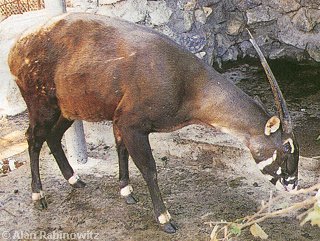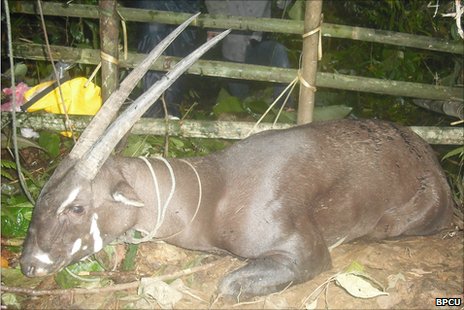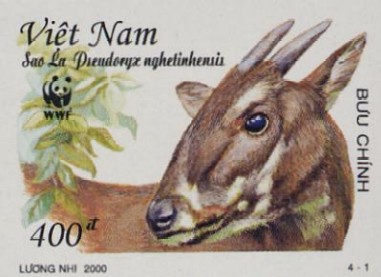
September 17, 2010

Earlier saola photo (above) by Alan Rabinowitz now joins the newest ones coming out of Laos.
The saola (Pseudoryx nghetinhensis), discovered less than twenty years ago, is still one of the world’s least frequently seen animals. Word is reaching the West that one was encountered in August 2010, caught alive, and then died in captivity. Such events are so rare, news of the incident is beginning to be widely reported by the Asian media and BBC News. Dozens of press articles on the news are appearing this morning.
The event is noteworthy. No zoologist or wildlife biologist has ever reported seeing a saola in the wild and there are none in captivity. The conservation group International Union for Conservation of Nature, which classifies saolas as critically endangered, notes there has not been a confirmed sighting of these animals in over ten years.

The saola are rarely encountered, let alone photographed.
Reportedly villagers from Laos’ central province of Bolikhamxay caught a adult male saola earlier this August, and brought it back to their village.
The villagers photographed the strange-looking mammal and then notified the Lao authorities. Unfortunately, by the time the Bolikhamxay Provincial Agriculture and Forestry Office team reached the remote location, the saola had died in captivity.
“The death of this Saola is unfortunate. But at least it confirms an area where it still occurs and the government will immediately move to strengthen conservation efforts there,” said a spokesperson of the provincial conservation unit of Bolikhamxay province, as reported by Katia Moskvitch, science reporter of the BBC News.

Sadly the meeting ended tragically, but maybe it will lead to renewed conservation efforts.
It will be recalled that the saola was found in the Annamite Mountains of Vietnam and Laos in 1992 by a team of scientists from the Vietnamese Ministry of Forestry and the World Wildlife Fund. The species was, at the time, the first large mammal to be discovered anywhere in the world since 1936.
The saola is a primitive member of the Bovidae family, which includes antelopes, buffalo, bison, cattle, goats and sheep. Although very little is known about the species, its global population is thought to be no more than 250 individuals, and its distribution highly restricted to only six provinces in Vietnam and four in Laos. The largest population thought to be found in the far south of the saola’s distribution range in Vietnam on the border between Thua Thien Hue and Quang Nam provinces where nature reserves have been established in recent years.
Continue cryptozoology into the future. Show your support today and…
Thank you.


Tip of the hat to Roddy Hayes of Legend Lures.
About Loren Coleman
Loren Coleman is one of the world’s leading cryptozoologists, some say “the” leading living cryptozoologist. Certainly, he is acknowledged as the current living American researcher and writer who has most popularized cryptozoology in the late 20th and early 21st centuries.
Starting his fieldwork and investigations in 1960, after traveling and trekking extensively in pursuit of cryptozoological mysteries, Coleman began writing to share his experiences in 1969. An honorary member of Ivan T. Sanderson’s Society for the Investigation of the Unexplained in the 1970s, Coleman has been bestowed with similar honorary memberships of the North Idaho College Cryptozoology Club in 1983, and in subsequent years, that of the British Columbia Scientific Cryptozoology Club, CryptoSafari International, and other international organizations. He was also a Life Member and Benefactor of the International Society of Cryptozoology (now-defunct).
Loren Coleman’s daily blog, as a member of the Cryptomundo Team, served as an ongoing avenue of communication for the ever-growing body of cryptozoo news from 2005 through 2013. He returned as an infrequent contributor beginning Halloween week of 2015.
Coleman is the founder in 2003, and current director of the International Cryptozoology Museum in Portland, Maine.
Filed under Breaking News, Classic Animals of Discovery, CryptoZoo News, Cryptozoology, New Species